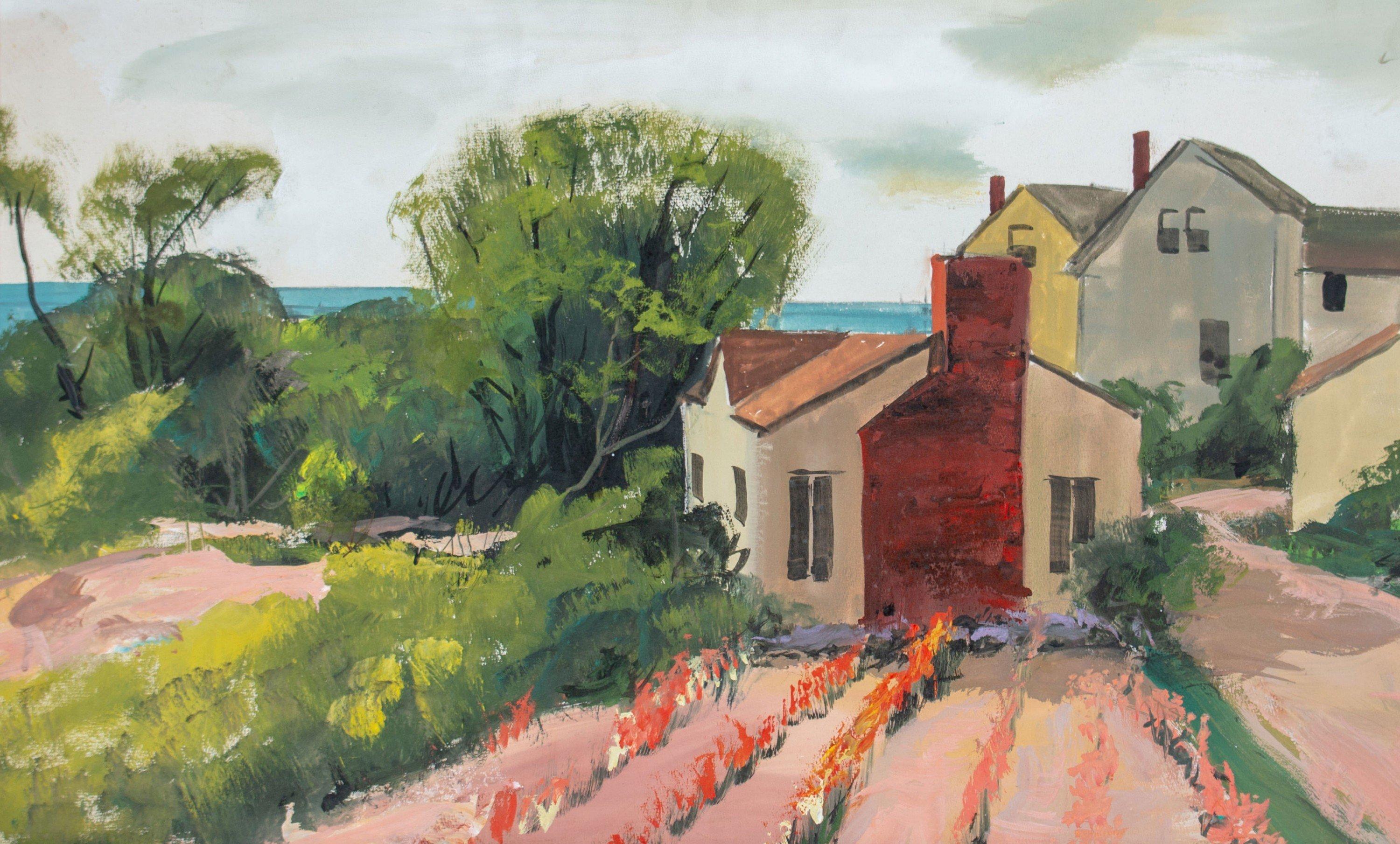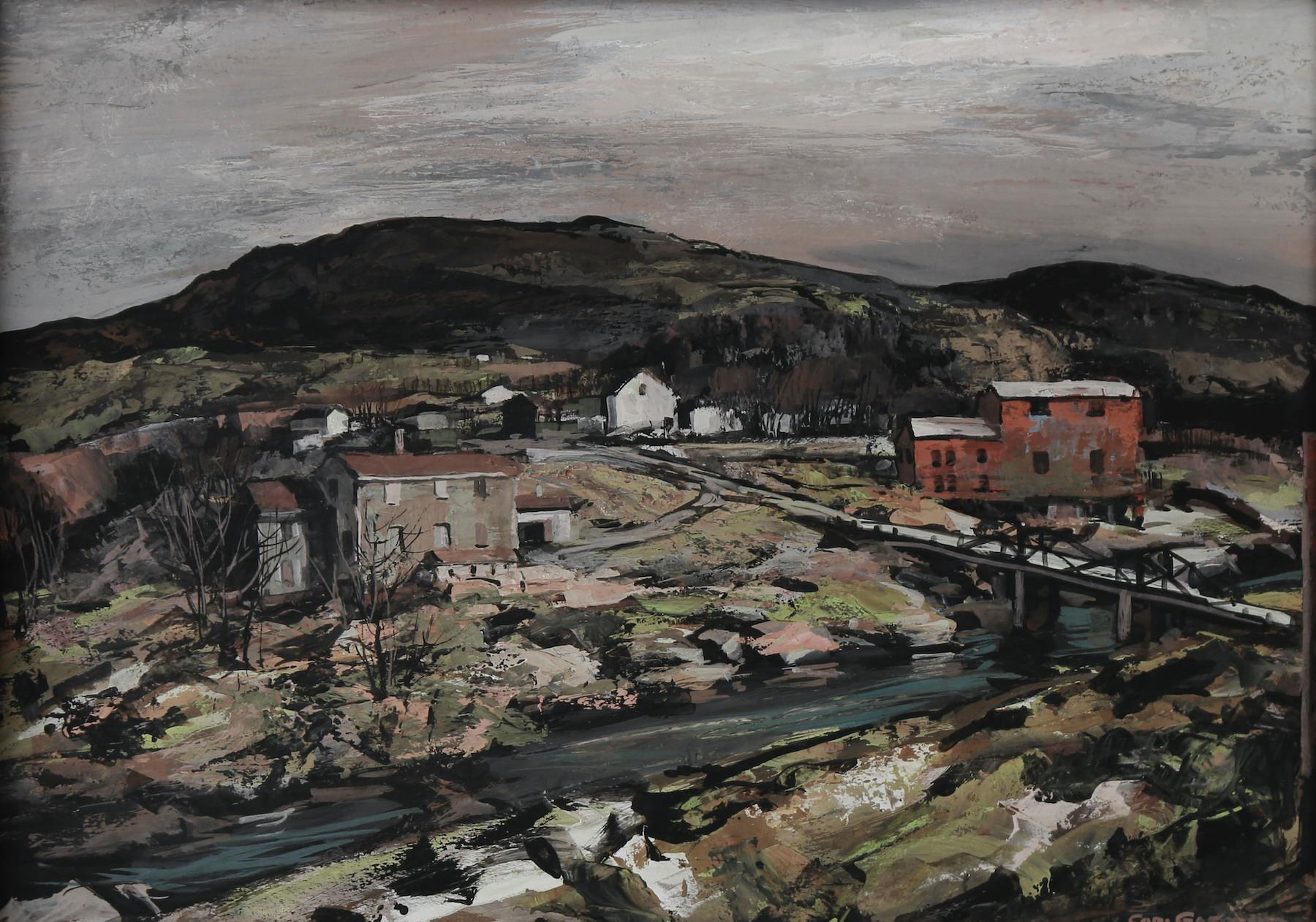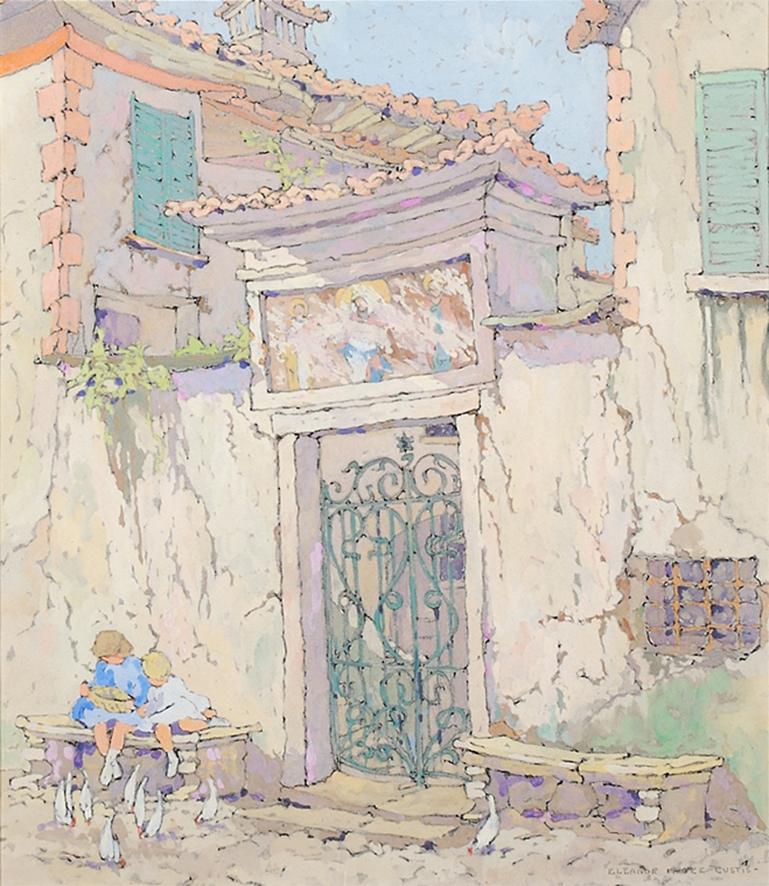Items Similar to St, Louis River Mural Study American Scene Social Realism Mid 20th Century WPA
Want more images or videos?
Request additional images or videos from the seller
1 of 7
Jo CainSt, Louis River Mural Study American Scene Social Realism Mid 20th Century WPAc. 1930s
c. 1930s
About the Item
St, Louis River Mural Study American Scene Social Realism Mid 20th Century WPA
Jo Cain (1904-2003)
The Drama of the St. Louis Great River
23 1/4 x 25 ½ inches
Gouache on board c. 1930s
Estate stamp verso
34 x 36 inches framed
Our gallery is pleased to present the exhibition, "Jo Cain: Echoes of an Era," a tribute to the enduring legacy of Joseph Lambert Cain and a celebration of his art that transcends time and remains relevant today. The exhibition features mural studies, works on paper and paintings from the 1930s and 40s, all are available on 1stDibs.
BIO
JOSEPH LAMBERT CAIN (1904–2003)
A painter, muralist, and art educator, Joseph Cain's work was consistently infused by the color and vibrancy of his native New Orleans, even as he pursued a career that took him far from home. Beginning at the age of sixteen, his educational journey led him first to the Art Institute of Chicago and then to the Art Students League in New York, where he was instructed by Kenneth Hayes Miller, Kimon Nicolaides and Vaclav Vytlacil. He later studied under the Abstract Expressionist Hans Hoffman. A 1929 Carnegie Fellowship funded a year's enrollment at the Sorbonne in Paris and travel throughout Europe; Cain also received multiple Tiffany Foundation Fellowships.
Using thickly applied paint, layered color planes, and multiple perspectives, Cain created paintings, including streetscapes, marine scenes, and landscapes, which were sometimes categorized as "decorative expressionism" beginning in the late 1930s.
In 1932, Cain's entry to the First Biennial Exhibition of Contemporary American Painting at the Whitney Museum of American Art hung in the exhibition's entry way; other works were shown at such prestigious venues as the Museum of Modern Art, American Art, Pennsylvania Academy of the Fine Arts, National Academy of Design, and Carnegie Institute.
He also executed a monumental mural at New York State Training School where he was employed as a teacher. While living in New York during this period, Cain was an integral member of a contemporary art collective known as "The Group," whose participants included Milton Avery, George Biddle, Robert Gwathmey, Marsden Hartley, John Marin, and many other important modernists.
Jo’s work evolved continuously. Moving from realism in the ‘20’s, he developed a highly personal, cubism based, abstract style similar in spirit to that of Stuart Davis and clearly influenced by Leger, Matisse and Picasso. In 1944, Cain joined the faculty at the University of Rhode Island, establishing and chairing the art department for over two decades. He continued creating art until his death.
- Creator:Jo Cain (1904)
- Creation Year:c. 1930s
- Dimensions:Height: 34 in (86.36 cm)Width: 36 in (91.44 cm)Depth: 2 in (5.08 cm)
- Medium:
- Movement & Style:
- Period:
- Condition:
- Gallery Location:New York, NY
- Reference Number:1stDibs: LU1156213251572
About the Seller
5.0
Platinum Seller
These expertly vetted sellers are 1stDibs' most experienced sellers and are rated highest by our customers.
Established in 2008
1stDibs seller since 2019
164 sales on 1stDibs
Typical response time: <1 hour
- ShippingRetrieving quote...Ships From: Pawling, NY
- Return PolicyA return for this item may be initiated within 3 days of delivery.
More From This SellerView All
- Street Scene WPA American Scene Mid-20th Century Modern Coin Tower California SFBy Victor Michail ArnautoffLocated in New York, NYStreet Scene WPA American Scene Mid-20th Century Modern Coin Tower California SF Victor Arnautofff (1896 – 1979) City Street 12 x 14 inches Oil on board, c. 1930s Signed lower left BIO Born in the Ukraine of Russia, Victor Arnautoff became one of the most influential muralists in San Francisco in the 1930s and worked for the Federal Arts Project, WPA, in the expressive, social protest...Category
1930s American Realist Figurative Paintings
MaterialsOil, Board
- Long Beach WPA Mid 20th Century American Scene Social Realism Modernism AshcanBy Daniel Ralph CelentanoLocated in New York, NYLong Beach WPA Mid 20th Century American Scene Social Realism Modernism Ashcan Daniel Ralph Celantano (1902-1980) "Long Beach" 8 x 10 inches Oil on artist board Signed lower left:...Category
1930s American Realist Figurative Paintings
MaterialsOil, Board
- Poker Players NYC Mid 20th Century Modern WPA American Scene Social RealismBy Philip ReismanLocated in New York, NYPoker Players NYC Mid 20th Century Modern WPA American Scene Social Realism Philip Reisman (1904-1992) Poker Players 12 x 16 oil on board Signed and dated 1949 lower right BIO Phi...Category
1940s American Realist Figurative Paintings
MaterialsOil, Board
- "Parade" Social Realism Mid 20th Century Modern American Scene WPA RegionalismBy Gerrit SinclairLocated in New York, NY"Parade" Social Realism Mid 20th Century Modern American Scene WPA Regionalism Gerrit Van Sinclair (1890 – 1955) Parade 20 x 15 inches Oil on board, c. 1940s Signed lower right Fram...Category
1940s American Realist Figurative Paintings
MaterialsOil, Board
- Bathers 1940s Mid 20th Century American Scene Social Realism WPA Modern AshcanLocated in New York, NYBathers 1940s Mid 20th Century American Scene Social Realism WPA Modern Ashcan Marion Gilmore (1909-1984) Bathers 15 1/2 x 19 1/2 inches oil on canvas boar...Category
1940s American Realist Figurative Paintings
MaterialsOil, Board
- UNION SQUARE Depression Era Oil Painting WPA Realism American Scene Realism NYCBy Jo CainLocated in New York, NYUNION SQUARE Depression Era Oil Painting WPA Realism American Scene Realism NYC Jo Cain (1904 – 2003) "Union Square," 24 x 36 inches. Oil on canvas, c.1940s, ...Category
1940s American Realist Figurative Paintings
MaterialsCanvas, Oil
You May Also Like
- Pulp Magazine Marine Combat Scene Shoot Out in Blue NoirLocated in Miami, FLWhat makes this work important? It's not that it's a commissioned artwork for a men's 60s pulp adventure magazine depicting the instant a soldier is shot. The big point of the painting is how brilliantly the formal elements are thought out, designed, and executed. John McDermott tells a story using a complex figural composition in an unexpected wide-angle vision. The work is as abstract as it is representation. His use of light is significant because it creates a high-contrast two-color style that bears the mark of its creator. This is a work done by a master artist/illustrator without peers compared to artists living today. If the contemporary art world gave awards for draftsmanship, painting technique, and graphic design .... John McDermott would win the highest accolades. Initialed lower left - unframed John McDermott (August 30, 1919 – April 20, 1977), also known under the pen names J.M. Ryan and Mariner, was an American illustrator and author noted for action and adventure illustrations.[1] McDermott worked as an in-between and effects animator for Walt Disney Studios and as a US Marine combat artist,before establishing himself as a cover illustrator for 1950s paperbacks and pulp magazines such as Argosy, American Weekly, and Outdoor Life. Under his J.M. Ryan pen name, he wrote the novels The Rat Factory (1971), a derogatory satire of Walt Disney and the Disney studio; Brooks Wilson Ltd (1967), on which the 1970 film Loving was based; and Mother's Day (1969) about Ma Barker. Under his own name, he novelized director-writer Bo Widerberg's screenplay for the 1971 film Joe Hill, which would be his final published book. Early life John Richard McDermott was born 30 August 1919 in Pueblo, Colorado, the younger of two sons of Henry McDermott, an oil broker. McDermott was a young child when his father committed suicide.[4] The family eventually moved to Los Angeles where McDermott's mother, Hazel, worked in a beauty parlor. He graduated from Hollywood High School in 1936. Although he had had no formal art education, he took a job as an artist at Walt Disney Animation Studios. Career Disney At Disney, McDermott worked as an in-betweener and effects animator on Brave Little Tailor, Pinocchio, The Reluctant Dragon and Fantasia. His experiences while working at Disney, particularly during the time of the 1941 Disney animators' strike, would later become the basis for his 1969 satirical novel The Rat Factory. McDermott left Disney to fight with US forces during World War II. US Marines McDermott World War II sketch titled "Buddy is Wounded" On September 29, 1942, McDermott enlisted with the US Marine Corps. He served as a "pistol and palette" combat artist assigned to the map-making section. As a sergeant with the III Amphibious Corps, McDermott was involved in battles in the South Pacific theater of war, documenting the Guam, Okinawa and the Guadalcanal Campaigns. McDermott considered his wartime years to be his art education. "In the Marines, as a combat artist, I traveled with the troops and for three years got all the drawing opportunity anyone could want. My work changed enormously during this time and I’m sure it was due to constant drawing, every single day, from life, just putting down what I saw around me. In a few instances it was a dangerous kind of scholarship." According to the Marine Corps history journal Fortitudine, McDermott was so prolific that his contemporary style pen-and-ink sketches became easily recognizable to both Marines, from published work in Leatherneck Magazine, and civilians, from glossy copies supplied by the Marine Corps to the nation's press.His wartime art appears in World War II history books and is displayed at the Pentagon and the National Museum of the Marine Corps. Illustration Following the end of World War II, McDermott moved from California to New York City to work as a freelance illustrator. McDermott made his reputation drawing modern action, war and adventure scenes. His work adorned the covers and inside story pages of popular pulp magazines of the 1950s such as Argosy, Adventure, Blue Book, Outdoor Life and American Weekly. McDermott's illustrations appeared on numerous covers of 1950s paperback novels published by Dell, Fawcett Gold Medal, Bantam Mystery and others. His action graphics were geared toward thriller and detective genres, such as Donald Hamilton's Matt Helm books Murderers' Row and The Betrayers. He also created covers for science fiction comic titles such as Voyage to the Deep[citation needed] and horror-themed paperbacks such as the classic 1955 science fiction novel The Body Snatchers...Category
1960s American Realist Figurative Paintings
MaterialsIllustration Board, Gouache
- 1840 rare watercolor, Native American encampment, Western Indian Unknown artistLocated in Buffalo, NYA rare mid 19th Century watercolor depicting Native Americans approaching a fort. The subjects appear to be from a Northern Plains Tribes, and arre approaching a palisades style f...Category
1840s American Realist Landscape Paintings
MaterialsPaper, Watercolor, Gouache
- Flower Garden, Cape Cod, Mid-Century Cleveland School PaintingBy Carl Frederick GaertnerLocated in Beachwood, OHCarl Frederick Gaertner (American, 1898-1952) Flower Garden, Cape Cod, c. 1940s Gouache on illustration board 17.5 x 29 inches 27 x 39 inches, as framed Carl Gaertner was one of the greatest painters to emerge from the Cleveland School...Category
1940s American Realist Figurative Paintings
MaterialsGouache
- Rock Creek, Mid-century Ohio Landscape Painting, Cleveland SchoolBy Carl Frederick GaertnerLocated in Beachwood, OHCarl Frederick Gaertner (American, 1898-1952) Rock Creek, 1950 Gouache on artist board Signed and dated 1950 lower right/inscribed verso 14 x 19.5 inches 20...Category
1950s American Realist Landscape Paintings
MaterialsGouache
- The GatewayBy Eleanor Parke CustisLocated in New York, NYSigned (lower right): ELEANOR PARKE CUSTISCategory
20th Century American Realist Landscape Paintings
MaterialsPaper, Gouache
- Battle Scene At Sea World War II . Dead Soldiers and Blood Red SeaBy Mort KünstlerLocated in Miami, FLThe artist invents and then captures a moment of a peak drama with soldiers being shot and bombs exploding. It's beautifully rendered. This work was published as a two-page spread...Category
1960s American Realist Landscape Paintings
MaterialsGouache
Recently Viewed
View AllMore Ways To Browse
C Manning Painting
Sell Watches San Diego
Paris Cafe Original Painting
Csok Istvan
Dali Kaufman
Edmund F Ward
Gold Flight Wallpaper
J Burnett Painting
Jan Janssen
Jeff Cunningham
Jesus As The Shepherd Oil Painting
Louis Ritman
Muller And Stuart
Wande Oseni
William Kalwick
Yoda Painting
Achilles Language
Alexander O Levy




